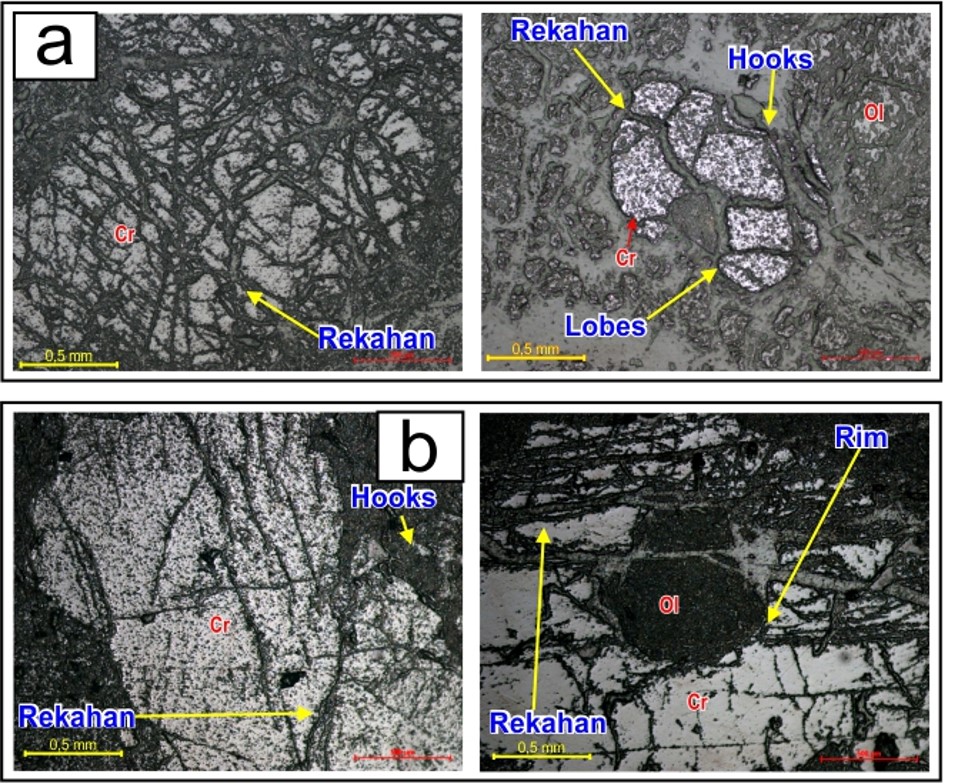Studi Mineralisasi Kromit Podiform pada Kompleks Ofiolit di Daerah Tapunopaka, Konawe Utara, Sulawesi Tenggara
DOI:
https://doi.org/10.56099/ophi.v5i1.p15-21Keywords:
Dunit, Harzburgit, Petrografi, Mineragrafi, Kompleks Ofiolit, Kromit podiformAbstract
Kompleks Ofiolit merupakan kompleks batuan yang sangat menarik untuk dibahas. Selain karena kompleksitas batuannya, kompleks batuan ini juga menjadi target eksplorasi untuk mineral ekonomisnya. Salah satu mineral ekonomis yang ada pada kompleks batuan ini yaitu mineral kromit. Mineralisasi kromit pada Kompleks Ofiolit merupakan tipe podiform sebagai konsentrasi kromit yang pada dasarnya berbentuk lentikular, mulai dari masif hingga tersebar, merupakan bagian integral dari urutan mantel ultramafik dari banyak kompleks ofiolit, terutama pada batuan harzburgit. Penelitian ini dilakukan di daerah Tapunopaka, Konawe Utara, dengan tujuan untuk mengetahui tipe kromit di lokasi penelitian berdasarkan teksturnya. Metode penelitian yang digunakan yaitu studi literatur, observasi lapangan, analisis petrografi, dan analisis mineragrafi. Mineralisasi kromit didaerah penelitian ditemukan pada batuan dunit dan harburgit. Berdasarkan hasil pengamatan megaskopis dan mikroskopis berupa analisis petrografi dan mineragrafi pada 4 sampel batuan berupa 2 sampel batuan dunit dan 2 sampel batuan harzburgit, mineral kromit pada daerah penelitian membentuk tekstur tersebar (disseminated) pada tubuh batuan dengan bentuk butir anhedral dan membentuk tekstur lobes dan hooks diantara mineral olivin dan ortopiroksen pada kedua batuan tersebut. Berdasarkan klasifikasi tipe kromit podiform berdasarkan tekstur tersebut tipe mineralisasi kromit di daerah penelitian adalah tipe kromit podiform non-kumulat
References
Arai, S. & Miura, M. 2015. Podiform chromitites do form beneath mid-ocean ridges. Lithos, 232, pp. 143-149. https://doi.org/10.1016/j.lithos.2015.06.015
Brathwaite, R. L., Christie, A. B. & Jongens, R. 2017. Chromite, platinum group elements and nickel mineralisation in relation to the tectonic evolution of the Dun Mountain Ophiolite Belt, east Nelson, New Zealand. New Zealand Journal of Geology and Geophysics, 60(3), pp. 255-269. https://doi.org/10.1080/00288306.2017.1313279
Chen, Y., Niu, Y., Duan, M., Gong, H. & Guo, P. 2021. Fractional crystallization causes the iron isotope contrast between mid-ocean ridge basalts and abyssal peridotites. Communications Earth & Environment, 2(1), pp. 65. https://doi.org/10.1038/s43247-021-00135-5
Edwards, S. J., Pearce, J. A. & Freeman, J. 2000. New insights concerning the influence of water during the formation of podiform chromitite. In: Dilek, Y., Moores, E. M., Elthon, D. & Nicolas, A. (eds.) Ophiolites and oceanic crust: new insights from field studies and the Ocean Drilling Program. Geological Society of America. pp. 139-147. https://doi.org/10.1130/0-8137-2349-3.139
Grond, H. C. 1982. A genetic model for alpine-type chromite deposits in the Josephine peridotite, Northwest California and Southwest Oregon, Thesis, University of British Columbia.
Hamilton, W. B. 1979. Tectonics of the Indonesian Region (Report No. 1078). Professional Paper, U.S. Govt. Print. Off. https://doi.org/10.3133/pp1078
Kadarusman, A., Miyashita, S., Maruyama, S., Parkinson, C. D. & Ishikawa, A. 2004. Petrology, geochemistry and paleogeographic reconstruction of the East Sulawesi Ophiolite, Indonesia. Tectonophysics, 392(1-4), pp. 55-83. https://doi.org/10.1016/j.tecto.2004.04.008
Le Bas, M. J. & Streckeisen, A. L. 1991. The IUGS systematics of igneous rocks. Journal of the Geological Society, 148(5), pp. 825-833. https://doi.org/10.1144/gsjgs.148.5.0825
Nicolas, A. 1989. Structures of Ophiolites and Dynamics of Oceanic Lithosphere. Springer Dordrecht. https://doi.org/10.1007/978-94-009-2374-4
Parkinson, C. 1998. Emplacement of the East Sulawesi Ophiolite: evidence from subophiolite metamorphic rocks. Journal of Asian Earth Sciences, 16(1), pp. 13-28. https://doi.org/10.1016/s0743-9547(97)00039-1
Roberts, S. 1988. Ophiolitic chromitite formation; a marginal basin phenomenon? Economic Geology, 83(5), pp. 1034-1036. https://doi.org/10.2113/gsecongeo.83.5.1034
Rollinson, H. & Adetunji, J. 2013. Mantle podiform chromitites do not form beneath mid-ocean ridges: A case study from the Moho transition zone of the Oman ophiolite. Lithos, 177, pp. 314-327. https://doi.org/10.1016/j.lithos.2013.07.004
Rusmana, E., Sukido, Sukarna, D., Haryono, E. & Simandjuntak, T. O. 1993. Peta Geologi Lembar Lasusua-Kendari, Sulawesi, skala 1 : 250.000. Bandung, Pusat Penelitian dan Pengembangan Geologi.
Schulte, R. F., Taylor, R. D., Piatak, N. M. & Seal, R. R. 2012. Stratiform chromite deposit model: Chapter E in Mineral deposit models for resource assessment (Report No. 2010- 5070E). Scientific Investigations Report, U.S. Geological Survey. https://doi.org/10.3133/sir20105070E
Thayer, T. P. 1964. Principal features and origin of podiform chromite deposits, and some observations on the Guelman-Soridag District, Turkey. Economic Geology, 59(8), pp. 1497-1524. https://doi.org/10.2113/gsecongeo.59.8.1497
Zaidan, M. & Garinas, W. 2021. Kajian Bahan Baku Mineral Nikel Untuk Baterai Listrik di Daerah Sulawesi Tenggara. Jurnal Rekayasa Pertambangan, 1(1), pp. 49-57.

Downloads
Published
How to Cite
Issue
Section
License
Copyright (c) 2023 Khalifa Akbar, Andri Slamet Subandrio, Masri Masri

This work is licensed under a Creative Commons Attribution-ShareAlike 4.0 International License.















